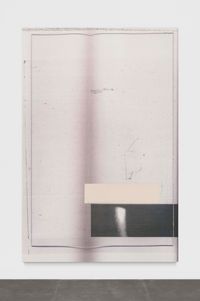
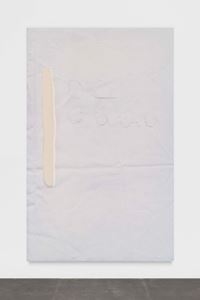
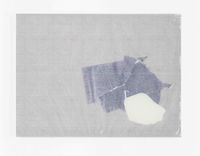
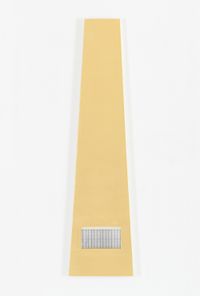
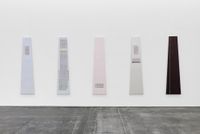
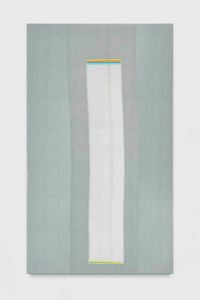
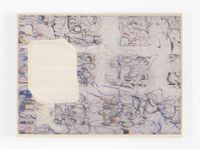
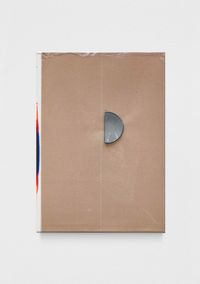
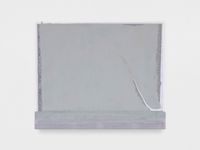
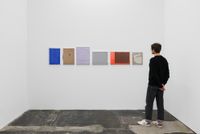
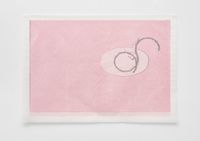
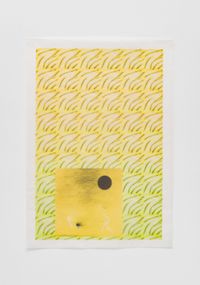
This exhibition took place at our previous Berlin location.
Galeria Plan B is pleased to announce the first solo exhibition of Marieta Chirulescu with the gallery, to open on Saturday, November 14.
pieces of spaces
...what we are seeing we cannot say. This is how an author concluded his essay on Marieta Chirulescu's painterly/photographic works¹ and practice, although in the previous pages he had, in fact, elaborated quite extensively on both the former and the latter.
There is a specificity to Chirulescu's works that's not always easy to parse. At first sight, they convey, elegantly and reservedly, a formal precision that initially suspends the intriguing imagery they deliver. But things get complicated once one tries to pierce through their dense visual fabric in order to arrive at an articulation of what they might be showing and 'doing'. This act of translation poses a challenge, since Chirulescu's paintings are paintings are photographs are paintings are copies are reproductions are originals. The images traverse different modes of the real and the virtual before, eventually, reaching the actual canvas and resting there in their composite, quasi-final form.
Chirulescu's practice started with painting on canvas. The finely layered, translucent backgrounds to her early, sparsely hinted figuration slowly emerged as the actual image in focus, superseding all traces of painted representation. As it turns out, this wasn't the artist's goodbye to representation, but rather her embracing a subjectively detached and yet strangely intimate approach to it–by introducing in her paintings the photographic images she would produce on the scanner glass. She would print these digitally manipulated images onto the support of her choice–mostly on canvas, and sometimes on paper. Other layers of paint could follow.
Photographic images stemming from office devices such as scanners differ greatly from representation conveyed by photo cameras. A scanner's vision sticks intimately onto the object of its inquisition. Although the main feature of their visual mechanics is flatness, scanned images are dutiful appropriators of reality since they perform a simulation of three-dimensionality that regular photographic images do not deliver. The dusty air between a flat sheet of paper and the scanning glass suffices for the resulting image to engender a sense of space. The scanning glass is at once a window and a stage. But a stage for what? Chirulescu is restrained in her use of imagery, or at least so it seems. An expression of the subverted but nevertheless repurposed modernist framework in Chirulescu's work is her cautious acknowledgment of the boundless expansion of digital images. While she uses the grid–an emblem of modernism–to structure her own abundant image archive, more or less to 'organise 'reality' by means of photographic integers', as Rosalind Krauss noted on Warhol in her essay Grids, Chirulescu also steers away from the excess of 'showing' that today is pervasive–particularly in the now most famous grid of all grids in social media. She rather constructs her compositions around representational hiatuses and around the static noise of her subtle, muted colours which oftentimes occupy most of the canvas' surface. Her interventions in this apparent visual–or rather verbal–wasteland most often happens on the fringes: she inserts conspicuously mundane fragments, vestiges of reality, I would claim not without a hidden dadaist impulse, treading a tightrope between the unruliness of the latter and the formal discipline of modernist references. And so, again, another nuance is added to the vague sense of intimacy that these images conjure. An ongoing performance of de- and re-stabilisation of order governs Chirulescu's images. A subversively feminine space, at once concrete and abstract, ensues as a result, with 'feminine' referring here to a form of its own rather than defined strictly by its opposition to the 'masculine'.
Aside from the many practical actions and decisions, there are essentially two movements in the process of Marieta Chirulescu's image-making: an additive and a subtractive movement that alternatively swap their functions to conceal or reveal, that is to make room for, or obstruct other visual layers. This process is one that has shaped her practice, whether in painting, printing, or in her more recent works with textile objects/drawings. It is an inquisitive attitude and an intuitive balancing act performed by the artist while inventing a room of her own in the space of the image.~~
Marieta Chirulescu, born 1974 in Sibiu, Romania, lives in Berlin, Germany. Solo exhibitions include: Foksal Gallery Foundation, Warsaw (2019); Pale Fire, Kurimanzutto, Mexico City (2016); CYTWOMBLY CYFONTI, Galeria Fonti, Napoli (2016); Marieta Chirulescu, Kunsthalle Lingen, Lingen (2014); Ileana, Micky Schubert, Berlin (2013); Marieta Chirulescu, White Cube Bermondsey, London (2011); Marieta Chirulescu, Kunstverein Nürnberg (2011); Werke aus der Sammlung Martin, Neues Museum, Nürnberg (2011); Marieta Chirulescu, Kunsthalle Basel, Basel (2010); Marieta Chirulescu, Kunsthalle Mainz, Mainz (2009); Marieta Chirulescu, Projektraum der Temporären Kunsthalle Berlin, (2009).
Group exhibitions include: Local talent, curated by Thomas Demand, Sprüth Magers, Berlin (2020); Marieta Chirulescu & Thu van Tran, Galerie Joseph Tang, Paris (2017); THE GAP BETWEEN THE FRIDGE AND THE COOKER, The Modern Institute, Glasgow (2017); #12 / Folies d'hiver, Villa Medici, Rome (2017); Präsentation 2015 Villa Massimo, Martin Gropius Bau, Berlin (2016); Image Support, Bergen Kunsthall Bergen (2016); Mapping Bucharest. Art, Memory, and Revolution (1916 - 2016), Vienna Biennale, MAK Vienna (2015); Attention Economy, Kunsthalle Wien (2014); Space, Space, curated by Dora Maurer, Museum Vasarely, Budapest (2014); Painting Forever!, KW Institute for Contemporary Art, Berlin (2014); Nur was möglich ist ist möglich, Museum Folkwang, Essen (2014); Les ateliers de Rennes, Biennale d'art Contemporain, Rennes (2012); Minimal Myth, Museum Boijmans Van Beuningen, Rotterdam (2012); Made In Germany Zwei, Sprengel Museum, Hannover (2012); La preuve concrète, Centre Européen d'Actions Artistiques Contemporaines, Strasbourg (2009); Against Interpretation, Studio Voltaire, London (2009); Nothing to say and I am saying it, Kunstverein Freiburg, Freiburg (2009); kettö/zwei, Goethe Institut, Budapest (2002).
Mihaela Chiriac, born 1984 in Brasov, Romania, is an independent curator and the co-founder of the project space STATIONS in Berlin, Kreuzberg.
To ensure the safety of visitors and staff, we kindly ask all visitors to respect the general recommendations for distancing and wearing a breathing protection mask in the gallery space at all times.
1 Mark Prince, 'Intransitive Vision', in: ed. Meike Behm, Marieta Chirulescu, Verlag für moderne Kunst Nürnberg, 2015.
Press release courtesy Galeria Plan B. Text: Mihaela Chiriac.
Potsdamer Strasse 77-87
Building G, Second Courtyard
Berlin, 10785
Germany
www.plan-b.ro
+49 303 980 5236
Tues - Sat, 12pm - 6pm by appointment